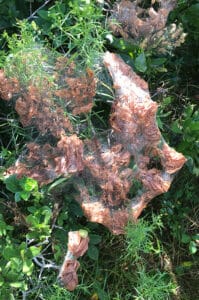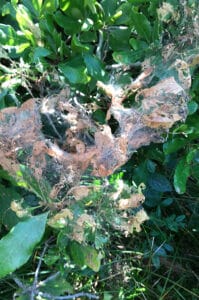by Dr. Sarah Treanor Bois
Director of Research & Education at the Linda Loring Nature Foundation
It’s not fall, and it’s not a worm.
So, what is it, you may ask? Fall webworm (Hyphantria cunea) is actually a common, native caterpillar that occurs throughout the United States and southern Canada. It is often mistaken for eastern tent caterpillars, but they are more active in early spring. As the name implies, fall webworm activity is seen much later in the season: generally August to early fall. This year on Nantucket, they began to be noticed at the beginning of August, when the caterpillars first started making their webs.


Unlike the eastern tent caterpillar (ETC), fall webworm nests are located at the ends of the branches and their loosely woven webs enclose the foliage. The ETC build their nests for temperature regulation, leaving the tent to feed. The fall webworm, by contrast, eats within its tent.
The fall webworm is a generalist feeder and they will make nests on almost any tree other than conifers. Hundreds of caterpillars can be found within the silken tent (or nest). The caterpillars feed inside the web and expand it as they grow. They stay in the colony until their last molt, after which they may be found crawling anywhere on the host plant. The fall webworm then crawls to a protected place to spin a flimsy cocoon and pupate for the winter. The adult emerges as a stunning white moth the following July.
Despite the look, fall webworm actually do little damage to a tree’s health other than aesthetically. This native insect has more than 50 natural predators and 36 parasites that help control it. Best of all, fall webworms do not eat the buds of next year’s leaves. Because they occur at the end of the growing season, they are actually feeding on leaves that are nearing the end of their photosynthesis careers and only have a bit more to give. Next year, the leaves will appear on the currently affected branches with no sign of last year’s damage.
So what should you do if you have fall webworm in your landscape?
Let them be: Fall webworm only makes the webbing during a short window of time each year. Soon it will make a cocoon and pupate. The webbing itself is biodegradable and will vanish from sight after a couple of storms. In the past, people have employed dangerous and foolhardy methods such as lighting the tents on fire, cutting the branches and using broad spectrum insecticide. Not only are these methods dangerous, but they can cause more harm to the tree in question than the caterpillar would have itself!
If you just can’t stand them, you can use a method known as “ten year old boy management.” With this method, you take a stick, poke the nest, and then wiggle it around until the webbing is more or less destroyed. While I don’t recommend any method that needlessly kills the caterpillars, it’s the least damaging to other organisms!


